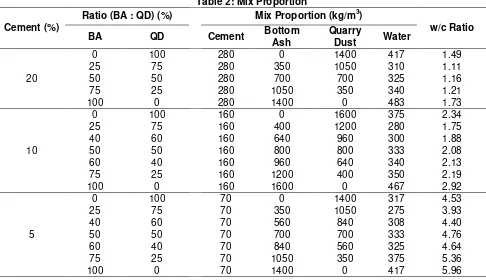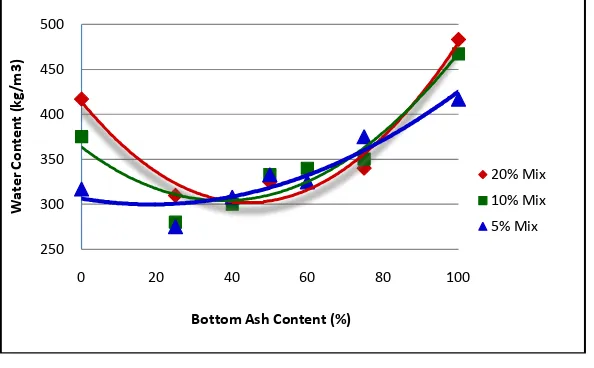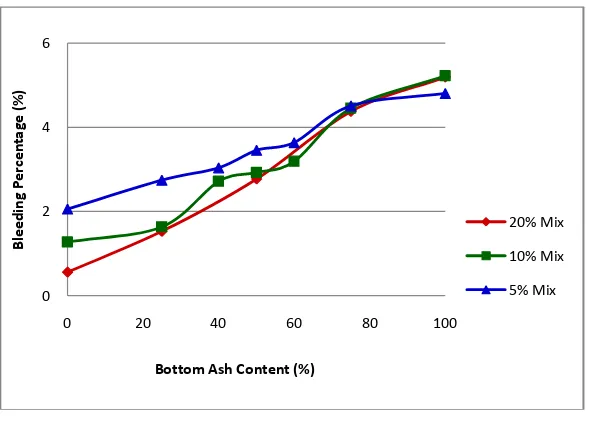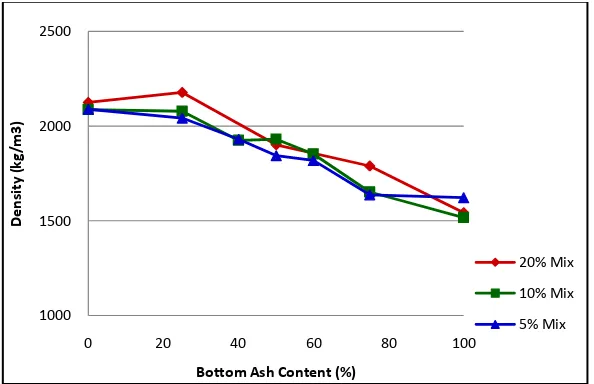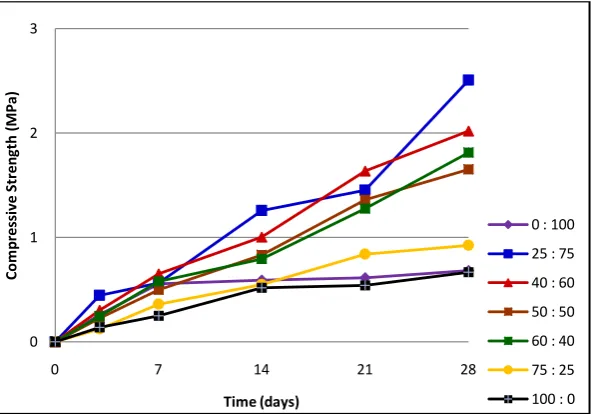On the Use of Quarry Dust and Bottom Ash as Controlled Low
Strength Materials (CLSM)
Djwantoro Hardjito1 and Sin Wing Why2 1
Department of Civil Engineering, Petra Christian University, Surabaya, Indonesia 2
Graduate, Department of Civil and Construction Engineering, Curtin University, Miri, Sarawak, Malaysia
Synopsis: This paper presents the study of Controlled Low Strengh Materials (CLSM) utilizing bottom ash (BA) from coal-fired power plant located in Kuching, Malaysia, and quarry dust (QD) as its fine aggregates and filler sources. The CLSM specimens were prepared by using cement, quarry dust, bottom ash and water only. The plastic properties (flowability, bleeding, segregation and setting time) and in-service properties (density and compressive strength) were measured to monitor the properties of specimens. Furthermore, the optimum ratio of bottom ash to quarry dust was also determined. The results reveals that the optimum water content required to achieve the desired flowability occurred when the ratio (by mass) of BA:QD in the range from 40:60 to 25:75. Mixture with higher bottom ash content content shows longer initial setting time. Bleeding is directly proportional to the bottom ash content while inversely proportional to the cement content. Maximum bleeding percentage of 5.22% is sited. Results also show that higher quarry dust content generates larger strength. The CLSM specimen is in best condition for BA:QD ratio ranges within 40:60 to 25:75.
Keywords: Controlled Low Strength Material, bottom ash, quarry dust, flowability, bleeding, segregation, setting time, density, compressive strength.
Introduction
The tremendous growth in production and manufacturing sectors in many countries leads to the increasing output of industrial wastes. For so many decades, these wastes were mainly disposed on site or land filled without any proper management. In year 2007, approximately 1.1 million metric tons of scheduled wastes were generated in Malaysia [1]. With Malaysia sets to increase the usage of coal as fuel supply in the next few years, the wastage generated will surely increase. Among these wastage, bottom ash would be occupying around 20% and most of them will be disposed onto ash ponds or by landfill. However, these are not options for the best sustainable solution, consequently other alternative solutions must be attained to solve this matter.
In Malaysia, quarry dust has been successfully used as a substitute for sand in concrete manufacture but the amounts are still limited. On the other hand, bottom ash has not been utilized in any sector yet due to its ‘undesirable’ properties such as high porosity and rough surface [2].
Controlled Low Strength Material is defined by ACI Committee 229 as self-compacted, cementitious material used primarily as backfill in lieu of compacted fill. Several terms are used to describe CLSM such as flowable fill, unshrinkable fill, controlled density fill, flowable mortar, plastic soil cement and soil-cement slurry [3]. In general, the compressive strength of CLSM is 8.3 MPa or less. It provides many advantages compared to conventional backfill method. Some of the advantages of CLSM including placement of material without compaction, less on site labour requirement, less heavy machinery required, strong, durable, readily available, suitable to use in narrow area where normal compacted fill is unreachable. CLSM is receiving increase attention in recent years as a promising material in civil construction due to its capability of making use of any types of waste [4]. The wastes that have been tested and used in CLSM include fly ash, bottom ash, quarry dust, foundry sand, ground granulated blast furnace slag and crushed glass [5].
Experimental Program
Materials and Mix Design
Cement is of Ordinary Portland Cement (OPC) type I manufactured in Bintulu, Malaysia. Low calcium bottom ash was obtained from coal-fired power plant located at Sejingkat, Kuching, Malaysia, while quarry dust of granite type was obtained from Batu Gading, Ulu Batang Baram, Miri, Malaysia. Sieve analysis has been conducted on bottom ash and quarry dust based on ASTM C136-06. Results tabulated in Table 1 indicate that quarry dust is a better fine aggregate source compared to bottom ash as the passing percentage of quarry dust is generally fall between the limit stated in ASTM C33/C33M-08. On the other hand, bottom ash is too fine to be a fine aggregate source. From the particle size point of view, it is a better filler source compared to quarry dust.
Table 1: Sieve Analysis for Bottom Ash and Quarry Dust AS 2758.1–
The bulk density of CLSM was set within range of 1840 to 2320 kg/m3 as specified by ACI Committee 229 [3]. Bulk proportion of raw materials was determined by varying the ratio (by mass) of cement, quarry dust, bottom ash and water. Raw materials were mixed for 15 minutes using a mixer. Additional water was added into the specimen during the mixing process to ensure that the required flowability value was achieved. Table 2 shows the mixture proportion of the specimen prepared for this study. For 5% and 10% cement content, the ratio of bottom ash to quarry dust by mass were set to be 100:0, 75:25, 60:40, 50:50, 40:60, 25:75 and 0:100 respectively. For 20% cement content, the ratio of bottom ash to quarry dust by mass were 100:0, 75:25, 50:50, 25:75 and 0:100.
The specimens were filled into fifteen 39.5mm diameter x 79mm height cylinder moulds and were cured in normal room temperature for the first 3 days. Then, the specimens were de-moulded and cured in controlled environment as per ASTM D4832-02.
Testing Program
Flowability Test was conducted by applying the inverted slump cone method with the test procedures conformed to ASTM D6103-04. Flow diameter of specimen was measured and the allowable region was set within 475–750mm [6]. Tamping was not necessary as CLSM is able to self-levelled due to its properties. Setting Time was measured by using mortar penetrometer as per ASTM C403. Bleed water was removed from the surface prior to testing as suggested by ASTM C403. The reason of removing the bleed water is because it will generally be drained off to the surrounding soil during actual field application [7]. Therefore, dry surface best indicating the real life application and thus this method was selected. The reported bleeding as specified by ACI Committee 229R is 10 to 20mm per metre of depth [3].
Segregation was measured by observing the distribution of quarry dust within the specimen. Larger particles tend to be crowded in the bottom region of specimen with high segregation. Density was measured for 3rd day density, dry density and 28th day density. Third day density was measured when the specimen was de-moulded in the third day after casting. Dry density was measured once the specimen was cured in normal room temperature for 7 days to monitor the specimen in dry condition. Twenty eight day density was measured on the 28th day after casting and this value indicates the final density of the specimen. Unconfined Compressive Strength was measured on the 3rd, 7th, 14th, 21st and 28th day. For CLSM used for backfill application, compressive strength of 0.3 to 0.7 MPa is adequate as it is identical to the allowable bearing capacity of a well compacted soil [8].
Results and Discussion
Flowability and Setting Time
Flowability is the main property that allows CLSM to be self-levelling and able to flow into voids easily without requiring any machinery or equipment. This represents the major advantage of CLSM compared to conventional backfill method [3]. Flowability Test has been conducted on all of specimens listed in Table 1. Water content has been adjusted based on the water requirement for different specimens to achieve the flow diameter of 475 to 750mm. Figure 1 shows the water content vs bottom ash content for 5%, 10% and 20% cement mix. Results show that the required water content decreases gradually from 0% bottom ash to 40% bottom ash and increases gradually from 40% to 100% bottom ash.
Figure 1: Water Content vs BA Content
Additional water is required when having high bottom ash content. This is most probably due to the porous properties of bottom ash. A study regarding water retainability of porous fine aggregate for design and quality of fresh concrete has been conducted by Kasemchaisiri and Tangtermsirikul. They have stated that the initial moisture content of bottom ash is higher than normal aggregates. Besides, bottom ash has angular shape and rough texture which induce surface friction. These properties cause immobility of bottom ash and reduce the workability of concrete [9]. Therefore, higher water content is needed to surpass the surface friction property of bottom ash to obtain good mix proportion. The downfall
of having higher water content is that it will induce bleeding and segregation. Therefore, bleeding and segregation will most probably occur in specimens with high bottom ash content.
Figure 2: Setting Time vs BA Content
Setting Time Test has been conducted on specimen with 5% cement mix. The initial setting time vs bottom ash content is shown in Figure 2. Results show that the initial setting time is proportional to the bottom ash content. Higher bottom ash content tends to cause longer setting time. The setting time value varies from 4.05 to 5.14 hours. Common setting time of CLSM as stated by ACI 229R is 3 to 5 hours for the need to support the weight of a person [3].
Bleeding and Segregation percentage occurred when there is higher bottom ash content within the specimen.
Figure 3: Bleeding Percentage vs BA Content
Previous research has shown that segregation is proportional to bleeding [4]. This is also shown by the results of this study where high bleeding value and segregation only occurred on high bottom ash content
mixture. This issue is most probably due to the water content of the mixture. ACI 229R has stated that segregation occurred at high levels of flowability. It is primarily caused by the use of excessive amount of water [3]. As discussed before, higher bottom ash content requires more water during mixing to produce the desired flowability. Therefore, the addition of water in higher bottom ash content tends to segregate the specimens and thus causing higher bleeding rate.
Density
Figure 4 shows the 28 days density vs bottom ash content for 20%, 10% and 5% cement content mix. Result shows that cement content has little influence towards density value as the mixes are having fairly equal density values. In contrast, this Figure clearly shows that density decreases when bottom ash content increased.
Lower density indicates the presence of voids within a specimen. As discussed earlier, higher bottom ash content results in lower density value, which indicates that more voids are present within the specimen. This is mainly due to the porosity and surface resistance behaviour of bottom ash, causing specimens containing high bottom ash content difficult to mix thoroughly. Voids are formed within the specimens and thus lowering the density value.
ACI 229R stated that the wet density of normal CLSM is in the range of 1840 to 2320kg/m3 [3]. Figure 4 shows that the 28th day density for 5% cement content mix ranges from 1623 to 2090kg/m3, for 10% cement content mix ranges from 1516 to 2086kg/m3 and for 20% cement content mix ranges from 1543 to 2125kg/m3. The results show that only CLSM containing BA:QD ratio of 50:50 to 0:100 has met the value recommended by ACI 229R.
Figure 4: BA Content vs 28th Day Density
Unconfined Compressive Strength
Unconfined Compressive Strength is the parameter that determines the load-carrying ability of CLSM. Compressive strength of 8.3 MPa or less has been defined by ACI 229R for this material [3]. Experimental results show that the 28th day strength for 5% cement mix ranges from 0.67 to 2.51 MPa, 10% cement mix ranges from 1.94 to 4.05 MPa and 20% cement mix ranges from 2.67 to 8.03 MPa. As expected, specimens with high cement content have greater strength compared to specimens with low cement content. Besides, specimens containing higher quarry dust content or lower bottom ash content tend to have greater strength. Figure 5 shows the compressive strength of CLSM with 5% cement content.
The result is reasonable as cement is the major raw materials which provide cohesion and strength for CLSM mixtures. Therefore, specimens containing more cement should generate higher strength. Results from sieve analysis show that quarry dust is coarser than bottom ash. With coarser material contributing to greater strength while porous properties of bottom ash contributing to lower strength, it is obvious that the compressive strength of CLSM is higher with higher quarry dust content.
Figure 5: Compressive Strength of CLSM with 5% Cement Mix
The Effect of Bottom Ash Content on Properties of CLSM
Referring to the test results, the quality of CLSM products made primarily by higher bottom ash content tends not to meet most of the required tested parameters. Therefore, usage of high bottom ash content in CLSM is not recommended. Instead, bottom ash is still recommended to be used as filler. Filler refers to material with size less than 0.075mm. It is responsible of filling the voids within specimens caused by coarser aggregates [11].
Sieve analysis results in this study (Table 1) shows that quarry dust contains only 1.1% material finer than 0.075mm while bottom ash contains 12.7% material finer than 0.075mm. Therefore, bottom ash is an idealized material to be a filler. Most results shows that when bottom ash content within a CLSM mixture is around 25 to 40%, the quality of final products are better than that of specimen with 100% quarry dust. Referring to Figure 1, optimum water content is achieved when bottom ash content is around 25 to 40%. Besides that, Figure 2 shows that the setting time of specimen is maintained within 4 to 4.5 hours while Figure 3 shows that the bleeding percentage has slight increment to 3% with the stated amount of bottom ash content being utilized. Most importantly, the strength of CLSM utilizing 25 to 40% of bottom ash is much higher than CLSM utilizing only quarry dust.
Conclusions
From this study of using BA from Kuching Power Plant, Malaysia, and locally available quarry dust of granite type, several conclusions can be drawn:
The optimum water content required for CLSM casting occurred when the ratio of BA:QD by mass is in the range from 40:60 to 25:75.
Setting Time of CLSM is influenced by the bottom ash and quarry dust content. Mixture with higher bottom ash content or lower quarry dust content shows longer initial setting time.
Bleeding is directly proportional to the bottom ash content while inversely proportional to the cement content. Maximum bleeding percentage of 5.22% is sited.
Segregation is directly proportional to bleeding. Specimens facing segregation issues are found having bleeding issues as well.
Cement content has little or no influence towards density of CLSM.
Density of CLSM is inversely proportional to the bottom ash content. Higher bottom ash content generates lower density value.
Compressive strength of CLSM is directly proportional to the cement content in a mixture. Besides that, results show that higher quarry dust content or lower bottom ash content generates larger strength.
The CLSM specimen is in best condition for BA:QD ratio by mass ranges within 40:60 to 25:75.
REFERENCES
[1]. Malaysia Environmental Quality Report. 2007. http://www.doe.gov.my/en/content/environmental-quality-report-eqr-2007 (accessed June 20. 2009).
[2]. Coal Bottom Ash/Boiler Slag. n.d. http://www.tfhrc.gov/hnr20/recycle/waste/ (accessed May 10, 2009).
[3]. ACI Committee 229R, 1999. Controlled Low-Strength Materials. ACI 229R-99
[4]. Naganathan, S., and H. A. Razak. 2008. Controlled Low-Strength Material Using Incinerator Bottom Ash and Quarry Dust. In The 3rd ACF International Conference-ACF/VCA: Vietnam.
[5]. Trejo, David, K. J. Folliard, and L. X. Du. 2004. Sustainable Development Using Controlled Low-Strength Material. In International Workshop on Sustainable Development and Concrete Technology:. Beijing, China.
[6]. Tripathi, H., C. E. Pierce, S. L. Gassman, and T. W. Brown. 2004. Methods for Field and Laboratory Measurement of Flowability and Setting Time of Controlled Low-Strength Materials.
Journal of ASTM International 1 (6):74-88.
[7]. Naik, Tarun R., R. N. Kraus, R. F. Sturzl, and B. W. Ramme. 1998. Design and Testing Controlled Low-Strength Materials (CLSM) Using Clean Coal Ash. The Design and Application of Controlled Low-Strength Materials (Flowable Fill), edited by A. K. Howard and J. L. Hitch: ASTM STP 1331. [8]. Controlled Low-Strength Material. 2008. Cement Concrete & Aggregates Australia.
[9]. Kasemchaisiri, R., and S. Tangtermsirikul. 2007. A method to determine water retainability of porous fine aggregate for design and quality control of fresh concrete. Construction and Building Materials 21 (6): 1322-1334. http://www.sciencedirect.com (accessed September 10 2009)
[10]. Razak, H.A., S. Naganathan, S.N.A Majid. 2009. Performance Appraisal of Industrial Waste Incineration Bottom Ash as Controlled Low-Strength Material. Journal of Hazardous Materials. doi:10.1016/j.jhazmat.2009.07.070
On the Use of Quarry Dust and Bottom Ash as Controlled Low
Strength Materials (CLSM)
Djwantoro Hardjito1 and Sin Wing Why2 1
Department of Civil Engineering, Petra Christian University, Surabaya, Indonesia 2
Graduate, Department of Civil and Construction Engineering, Curtin University, Miri, Sarawak, Malaysia
Introduction
CLSM is defined by ACI Committee 229R as a self-compacted cementitious material used primarily as backfill in lieu of compacted fill. Several terms are used to describe CLSM such as flowable fill, unshrinkable fill, controlled density fill, flowable mortar, plastic soil cement and soil-cement slurry. In general, the compressive strength of CLSM is 8.3 MPa or less. It provides many advantages compared to conventional backfill method, including placement of material without compaction, less on site labour requirement, less heavy machinery required, strong, durable, readily available, suitable to use in narrow area where normal compacted fill is unreachable. CLSM is receiving increase attention in recent years as a promising material in civil construction due to its capability of using any types of waste. The wastes that have been tested and used in CLSM include fly ash, bottom ash, quarry dust, foundry sand, ground granulated blast furnace slag and crushed glass.
Although most of the industrial wastes have been tested and used successfully in CLSM application, there is still lack of information on the optimum composition of CLSM mixtures utilizing bottom ash and quarry dust, and its plastics and in-service properties. This paper presents the findings of experimental investigation carried out on CLSM mixtures using low calcium bottom ash (BA) from Kuching coal combustion power plant in Malaysia and quarry dust (QD) of granite type as its fine aggregates and filler sources. The behaviour of CLSM under different ratio of bottom ash and quarry dust is also discussed.
Results and Discussion
Flowability and Setting Time
Flowability is the main property that allows CLSM to be self-levelling and able to flow into voids easily without requiring any machinery or equipment. This represents the major advantage of CLSM compared to conventional backfill method. Flowability Test has been conducted on all of specimens. Water content has been adjusted based on the water requirement for different specimens to achieve the flow diameter of 475 to 750mm. Results show that the required water content decreases gradually from 0% bottom ash to 40% bottom ash and increases gradually from 40% to 100% bottom ash.
Additional water is required when having high bottom ash content. This is most probably due to the porous properties of bottom ash and its rough texture. Higher water content is needed to surpass the surface friction property of bottom ash to obtain good mix proportion. The downfall of having higher water content is that it will induce bleeding and segregation. Therefore, bleeding and segregation will most probably occur in specimens with high bottom ash content.
Setting Time Test has been conducted on specimen with 5% cement mix. Results show that the initial setting time is proportional to the bottom ash content. Higher bottom ash content tends to cause longer setting time. The setting time value varies from 4.05 to 5.14 hours. Common setting time of CLSM as stated by ACI 229R is 3 to 5 hours for the need to support the weight of a person.
Bleeding and Segregation
The bleed percentage for 20% cement content varies from 0.55% to 5.20%, for 10% cement content varies from 1.27% to 5.22% and for 5% cement content varies from 2.06% to 4.80%. Razak and co. reported the bleeding percentage varies from 1.2% to 7.2% in CLSM made using incinerator bottom ash. Therefore, the bleeding of the specimens is considered normal. Higher bleeding percentage occurred when there was higher bottom ash content within the specimen.
desired flowability. Therefore, the addition of water in higher bottom ash content tends to segregate the specimens and thus causing higher bleeding rate.
Density
Density indicates the presence of voids within a specimen. Higher bottom ash content results in lower density value, which indicates that more voids are present within the specimen. This is mainly due to the porosity and surface resistance behaviour of bottom ash. Therefore, specimens containing high bottom ash content are difficult to mix thoroughly. Voids are formed within the specimens and thus lowering the density value.
ACI 229R stated that the wet density of normal CLSM is in the range of 1840 to 2320kg/m3. The 28th day density for 5% cement content mix ranges from 1623 to 2090kg/m3, for 10% cement content mix ranges from 1516 to 2086kg/m3 and for 20% cement content mix ranges from 1543 to 2125kg/m3.
Unconfined Compressive Strength
Unconfined Compressive Strength is the parameter that determines the load-carrying ability of CLSM. Experimental results show that the 28th day strength for 5% cement mix ranges from 0.67 to 2.51 MPa, 10% cement mix ranges from 1.94 to 4.05 MPa and 20% cement mix ranges from 2.67 to 8.03 MPa. As expected, specimens with high cement content have greater strength compared to specimens with low cement content. Besides, specimens containing higher quarry dust content or lower bottom ash content tend to have greater strength.
The result is reasonable as cement is the major raw materials which provide cohesion and strength for CLSM mixtures. Therefore, specimens containing more cement should generate higher strength. Results from sieve analysis show that quarry dust is coarser than bottom ash. With coarser material contributing to greater strength while porous properties of bottom ash contributing to lower strength, it is obvious that the compressive strength of CLSM is higher with higher quarry dust content.
The Effect of Bottom Ash Content on Properties of CLSM
The quality of CLSM products made primarily by higher bottom ash content tends not to meet most of the required tested parameters. Therefore, usage of high bottom ash content in CLSM is not recommended, although bottom ash, up to a certain percentage, is still possible to be used as filler. Filler refers to material with size less than 0.075mm, it is responsible for filling the voids within specimens caused by coarser aggregates.
Sieve analysis results in this study shows that quarry dust contains only 1.1% material finer than 0.075mm while bottom ash contains 12.7% material finer than 0.075mm. Therefore, bottom ash is an idealized material to be a filler. Most results shows that when bottom ash content within a CLSM mixture is around 25 to 40%, the quality of final products are better than that of specimen with 100% quarry dust. Optimum water content is achieved when bottom ash content is around 25 to 40%. Besides that, the setting time of specimen is maintained within 4 to 4.5 hours while the bleeding percentage has slight increment to 3% with the stated amount of bottom ash content being utilized. Most importantly, the strength of CLSM utilizing 25 to 40% of bottom ash is much higher than CLSM utilizing only quarry dust.
Conclusions
From this study of using BA from Kuching Power Plant, Malaysia, and locally available quarry dust of granite type, several conclusions can be drawn:
The minimum water content required for CLSM casting occurred when the ratio of BA:QD by mass is in the range from 40:60 to 25:75.
CLSM mixture with higher bottom ash content shows longer initial setting time.
Bleeding is directly proportional to the bottom ash content while inversely proportional to the cement content. Maximum bleeding percentage of 5.22% is sited.
Segregation is directly proportional to bleeding. Specimens facing segregation issues are found having bleeding issues as well.
Higher bottom ash content generates lower density value.
Compressive strength of CLSM is directly proportional to the cement content in a mixture. Besides that, results show that higher quarry dust content or lower bottom ash content generates larger strength.
